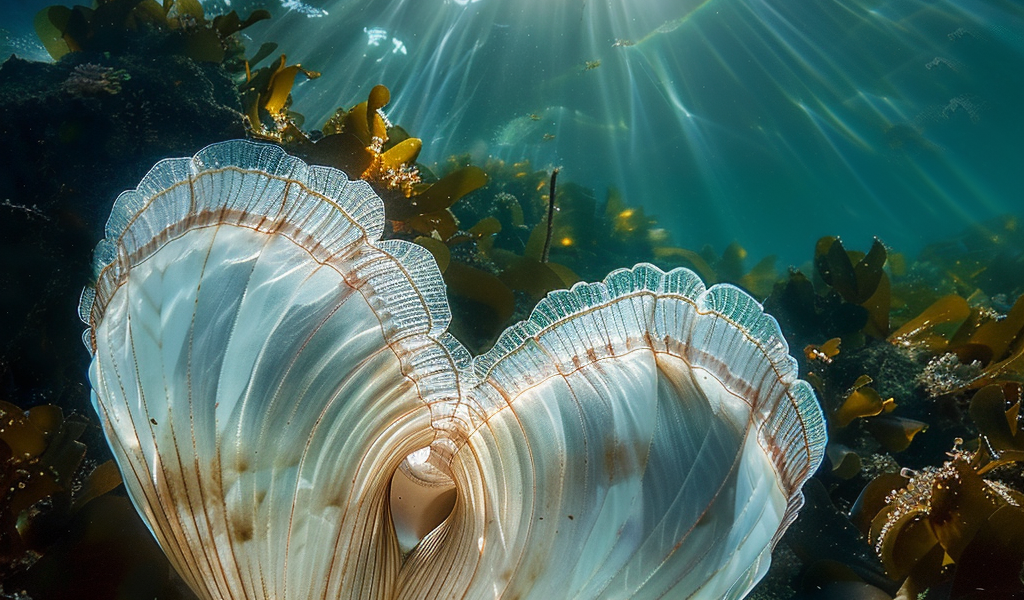In a groundbreaking discovery, researchers have unveiled that heart cockles, a type of marine mollusk, possess sophisticated shell structures that function similarly to fiber optic cables. This revelation highlights the remarkable evolutionary adaptations of these clams, which have developed unique features to optimize their symbiotic relationship with algae.
The study, conducted by teams from Duke University and Stanford University, was published in the journal Nature Communications on November 19, 2024. The research focuses on the heart cockle (Corculum cardissa), a bivalve found in the warm equatorial waters of the Indo-Pacific region. These clams have heart-shaped shells that house microscopic algae, forming a mutually beneficial partnership.
Heart cockles thrive in a delicate ecosystem where the algae, residing within the clams’ tissues, rely on light for photosynthesis. In return for providing shelter, the clams benefit from the sugars produced by the algae, creating a sustainable source of nourishment. However, the challenge for the clams lies in delivering sufficient light to the algae without exposing themselves to predators.
To tackle this challenge, heart cockles have evolved translucent areas in their shells, which act as natural skylights. These structures allow light to penetrate deep into the clam’s interior, where the algae reside, thus ensuring their survival and growth. The researchers employed advanced techniques, including electron and laser microscopy, to analyze the intricate design of the heart cockle’s shell.
According to Dakota McCoy, the study’s lead author and an assistant professor at the University of Chicago, the clams have developed a system of hair-thin strands arranged in bundles that effectively channel light into their shells. Beneath each translucent window, tiny bumps smaller than a grain of sand serve as lenses, focusing sunlight into beams that penetrate the clam’s interior.
McCoy likened this natural design to an organic cathedral, where the translucent shells act like stained glass windows, allowing light to filter in and nourish the algae within. This innovative adaptation not only supports the clams’ symbiotic relationship with the algae but also showcases the incredible ingenuity of nature in solving complex biological challenges.
The discovery of these natural skylights in heart cockles has implications beyond marine biology. The insights gained from studying these mollusks could inform the development of more efficient fiber optic technologies. As fiber optic cables are integral to modern communication systems, understanding how heart cockles manage light transmission could inspire new designs that enhance the performance of these cables.
Heart cockles utilize a special form of calcium carbonate called aragonite to construct their shells. The layered structure of the shell, observed under a scanning electron microscope, reveals the intricate patterns that contribute to its optical properties. This layered architecture not only provides structural strength but also plays a crucial role in light manipulation.
The findings of this research underscore the importance of studying natural systems to uncover innovative solutions to modern technological challenges. By examining how heart cockles have adapted to their environment, scientists can gain valuable insights into the principles of light transmission and apply these lessons to the design of advanced materials and devices.
As researchers continue to explore the fascinating world of marine biology, the heart cockle serves as a reminder of the intricate relationships that exist within ecosystems and the potential for nature to inspire technological advancements. This study opens the door to further investigations into the optical properties of other marine organisms and their applications in various fields, including telecommunications, medicine, and materials science.
In summary, the heart cockle’s unique adaptations provide a compelling example of how evolutionary processes can lead to innovative solutions for survival. The study not only sheds light on the biology of these remarkable clams but also highlights the potential for harnessing natural designs to enhance human technology.





